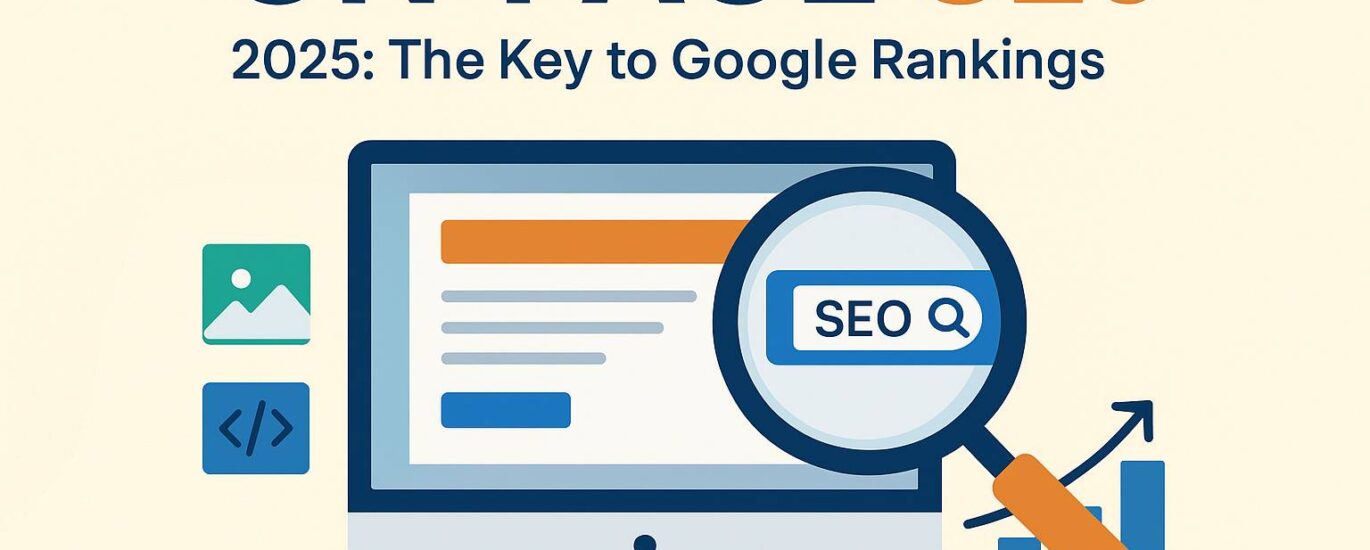Search Engine Optimization (SEO) has always been the backbone of online visibility. But as Google’s algorithms evolve, on-page SEO has become more crucial than ever. In 2025, search engines reward websites that deliver value, clarity, and exceptional user experience — and on-page SEO sits at the heart of all three.
This blog explains what on-page SEO means, its core elements, and why it’s essential for ranking higher on Google this year.
What Is On-Page SEO?
On-page SEO (also called on-site SEO) refers to all the optimization techniques you apply directly on your website to help search engines understand your content and rank it correctly.
It involves:
- Crafting relevant, keyword-focused content
- Optimizing meta tags, headings, and URLs
- Improving page structure, internal linking, and images
- Ensuring mobile-friendliness and fast load speed
Simply put, on-page SEO tells Google what your page is about — and why it deserves to rank above others.
Why On-Page SEO Matters in 2025
In 2025, Google’s ranking system is smarter than ever. Thanks to AI-driven updates and semantic search, Google no longer relies on keywords alone — it interprets intent.
That’s where on-page SEO helps: it gives Google the context it needs to connect your page with user intent.
Here’s why it’s crucial:
1. It Improves Search Relevance
When you optimize title tags, headings, and content structure around user intent, Google instantly understands your topic. This improves your relevance score and visibility in SERPs (Search Engine Results Pages).
2. It Enhances User Experience (UX)
A well-optimized page is easy to read, loads fast, and guides users naturally toward what they want. Since UX signals (like bounce rate and dwell time) influence rankings, better on-page optimization means higher engagement — and better ranking potential.
3. It Strengthens Keyword Strategy
On-page optimization allows you to balance primary keywords with semantic (LSI) terms, creating a natural keyword ecosystem that aligns with Google’s RankBrain and BERT algorithms.
4. It Builds Content Authority
Internal linking, proper heading hierarchy, and high-quality information show Google that your content is organized and credible — a key factor for achieving featured snippets and People Also Ask positions.
5. It Helps Compete Organically
Even if your competitors invest heavily in paid ads, strong on-page SEO ensures your pages perform well organically — saving long-term marketing costs.
Learn More: Off-Page SEO Guide
Key On-Page SEO Elements to Focus on in 2025
1. Title Tags & Meta Descriptions
Your title tag is the first thing both users and search engines notice. Keep it under 60 characters, include your target keyword, and make it click-worthy.
Example:
On-Page SEO in 2025: How to Rank Higher on Google the Smart Way
Meta descriptions should summarize your content (under 160 characters) with a clear call-to-action.
2. Header Tags (H1–H6)
Use headers logically:
- H1: Main topic (only one per page)
- H2/H3: Subtopics with keywords
Headers improve readability and help Google understand your content hierarchy.
3. Content Optimization
- Write original, value-driven content of at least 800–1500 words.
- Naturally integrate keywords without stuffing.
- Add multimedia (images, videos, infographics) with optimized alt text.
- Include FAQ sections targeting long-tail queries.
4. URL Structure
Clean URLs perform better.
✅ Example: www.hireseoexpertindia.com/on-page-seo-guide
❌ Avoid: www.hireseoexpertindia.com/post?id=12345
Keep them short, descriptive, and keyword-rich.
5. Internal & External Links
Link relevant pages within your website to improve crawl depth and help users explore related topics.
Also, reference authoritative external sources (like Google, Moz, or HubSpot) to add credibility.
6. Image SEO
Use high-quality, compressed images and include descriptive alt text with keywords. Image search drives significant traffic in 2025 — an often-overlooked SEO goldmine.
7. Mobile Optimization & Page Speed
Google’s mobile-first indexing means your site’s mobile version is what determines ranking.
Use tools like Google PageSpeed Insights and Core Web Vitals to monitor load time, interactivity, and visual stability.
8. Schema Markup (Structured Data)
Implement schema markup to help Google display rich snippets — star ratings, FAQs, product details, and more. It improves click-through rates by up to 30%.
Pro Tip: Content Freshness = SEO Power
In 2025, Google favors updated content. Regularly refresh older articles with new data, stats, and visuals. Add recent trends or algorithm insights to stay relevant.
Final Thoughts
On-page SEO is no longer about ticking technical boxes — it’s about delivering exceptional value to both users and search engines. When done right, it boosts your visibility, authority, and conversions.
If you want your website to dominate Google rankings in 2025, start by perfecting your on-page SEO foundation — because without it, no amount of backlinks or paid ads can sustain long-term success.
Need help improving your on-page SEO? Get a free site audit today at https://sharma-vivek.com/.




